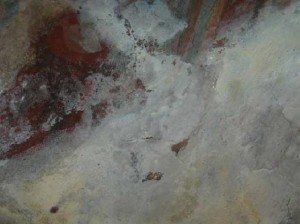Mexico recently hosted (Feb. 7 – 8, 2013) a pair of conferences focused on nanotechnology and art conservation. The country is part of an international consortium in the European Commision’s Seventh Framework Programme (FP7), NanoForArt project. Before mentioning the conference, here’s a little information about the NanoForArt project from its homepage,
The main objective of the NANOFORART proposal is the development and experimentation of new nano-materials and responsive systems for the conservation and preservation of movable and immovable artworks. [emphasis mine]
While the progress in material science has generated sophisticated nanostructured materials, conservation of cultural heritage is still mainly based on traditional methods and conventional materials that often lack the necessary compatibility with the original artworks and a durable performance in responding to the changes of natural environment and man-made activities.
The main challenge of NANOFORART is the combination of sophisticated functional materials arising from the recent developments in nano-science/technology with innovative techniques in the restoration and preventive conservation of works of art, with unprecedented efficiency.
Immovable artworks tend to be things like cave art, frescoes, and other forms of wall and rock art. The Feb. 2013 conferences in Mexico as per a Feb. 27, 2013 Agencia EFE news item on the Global Post website featured (Note: Links have been removed),
Baglioni [Piero Baglioni, a researcher and professor at the University of Florence] and Dr. Rodorico Giorgi, also of the University of Florence, traveled to Mexico earlier this month to preside over a conference on Nanotechnology applied to cultural heritage: wall paintings/cellulose, INAH [Instituto Nacional de Antropología e Historia] said.
The project includes specialists from Italy, Spain, Britain, France, Denmark, the Czech Republic, Germany, Slovenia and Mexico and is coordinated by the CSGI center [Center for Colloids and Surface Science] at the University of Florence.
NANONFORART is set to conclude in December 2014 with the “validation of the technology and the methods developed, as well as training activities,” INAH said.
Until now, preservation of cultural treasures has been carried out using conventional materials that are often incompatible with the works and can, over time, alter the appearance of the object.
Baglioni has worked with INAH personnel to clean and restore pre-Columbian murals at the Cacaxtla, Cholula, Tlatelolco, Mayapan, El Tajin, Monte Alban and Teotihuacan sites.
I have mentioned Baglioni’s work in Mexico previously in a Sept. 20, 2010 posting about some work at La Antigua Ciudad Maya de Calakmul, an archaeological site which is located in the Campeche state.
Unfortunately, there aren’t too many details about the conferences, the Feb. 7, 2013 conference sported the previously noted title (in the Agencia EFE news item), Nanotechnology Applied to Cultural Heritage: Wall Paintings/Cellulose, and the Feb. 8, 2013 conference was titled, Nanotechnology for the Cleaning of Cultural Heritage.
There’s more information about nanotechnology aspects on the NanoForArt Overall page (Note: Links have been removed),
The work plan will start with design and formulation of nanostructured systems with special functionalities (WP1) such as deacidification of movable artworks (paper, parchment, canvas, leather), cleaning of movable artworks (paper, parchment, canvas paintings), protection of movable artworks (paper, canvas), consolidation of immovable artworks (wall-paintings, plaster and stones), and cleaning of immovable artworks (wallpaintings, plaster and stones). These systems, whose formulation will be optimized according to their functions, will include microemulsions, micellar solutions, gels and dispersions of different kinds of nanoparticles. A physico-chemical characterization of the developed materals (WP2) will constantly support the formulation activity. This will allow to understand and control the nature of interaction mechanisms between these nanostructures and the target substances/supports.
Assessment of the applicability of materials (WP3) will start in the second half of the first year. In this phase the up-scale of the technologies from the laboratory to the market level will be tackled. All the partners will interact in order to clarify and merge the priority from all the points of view. Evaluation of possible human health effects and environmental impacts of developed nanomaterials for restoration (WP7) will also start in the second half of the first year. Special emphasis will be given to potential hazardousness of nanoparticles used for design and formulation of nanostructured systems, as well as environmental impacts associated with the use of these nano-based products.
Nanotechnology developed by NANOFORART will aim also to significantly reduce the use of harmful solvents, as well as to introduce new environmentally friendly nanomaterials. Once the applicability and safety of the developed materials will be assessed, the development of industry process (WP4, WP5) will start in order to transfer technology on the market by the standardization of the applicative protocols and production of the nanomaterials on medium and large scale. Small and Medium Enterprise (SME) partners will have their main competence in this phase, that should start at the beginning of the second year. Safety and health risks of the industry processes will be also assessed. At the end of the first year, a study of the long-term behavior of the products and of the treated works of art (WP6) will be started by means of artificial ageing, in order to avoid damages due to unforeseen phenomena. The partners will have their main competence in ageing, monitoring of environmental pollution, and control of exhibitions and museums conditions.
The project is scheduled for completion in 2014.
The aspect I find most interesting is the ‘immovable art’. There was a controversy in Spain in 2011 over the prospect of opening some caves to tourists, from the Oct. 26, 2011 news item on ScienceDaily,
Plans to reopen Spain’s Altamira caves are stirring controversy over the possibility that tourists’ visits will further damage the 20,000-year old wall paintings that changed views about the intellectual ability of prehistoric people. That’s the topic of an article in the current edition of Chemical & Engineering News, ACS’ weekly newsmagazine. The caves are the site of Stone Age paintings so magnificent that experts have called them the “Sistine Chapel of Paleolithic Art.”
Carmen Drahl, C&EN associate editor, points out in the article that Spanish officials closed the tourist mecca to the public in 2002 after scientists realized that visitors were fostering growth of bacteria that damage the paintings. Now, however, they plan to reopen the caves. Declared a World Heritage Site by the United Nations’ Educational, Scientific and Cultural Organization (UNESCO), Altamira’s rock paintings of animals and human hands made scientists realize that Stone Age people had intellectual capabilities far greater than previously believed.
You can find an Oct. 6, 2011 piece about the Altamira rock paintings by Drahl titled, Keeping Visitors Out To Keep Cave Paintings Safe, on the Chemical and Engineering News (C&EN) blog. For anyone interested in more about rock art, there’s a UNESCO (United Nations Educational, Scientific, and Cultural Organization) World Rock Archives project or, as they call them, activity,
Due to their long sequence chronology, susceptibility to climate changes and vandalism, rock art sites are also among the most vulnerable on the World Heritage List.
Rock art, in the form of paintings and engravings, is a clear and lasting evidence of the transmission of human thoughts and beliefs through art and graphic representations. It functions as a repository of memory, enabling each culture to speak about themselves and their origins in all geographical settings.
I have two more items on cave art. The first is a piece I’ve been wanting to feature for almost two years. It’s an article on Slate by John Jeremiah Sullivan dated March 21, 2011 and titled, America’s Ancient Cave Art
Deep in the Cumberland Plateau, mysterious drawings, thousands of years old, offer a glimpse of lost Native American cultures and traditions. It’s an excerpt of an essay Sullivan wrote for the Paris Review. A fascinating exploration of a cave system that isn’t nearly as well known as France’s Lascaux Caves, here’s a snippet,
Over the past few decades, in Tennessee, archaeologists have unearthed an elaborate cave-art tradition thousands of years old. The pictures are found in dark zone sites—places where the Native American people who made the artwork did so at personal risk, crawling meters or, in some cases, miles underground with cane torches—as opposed to sites in the “twilight zone,” speleologists’ jargon for the stretch, just beyond the entry chamber, which is exposed to diffuse sunlight. A pair of local hobby cavers, friends who worked for the U.S. Forest Service, found the first of these sites in 1979. They’d been exploring an old root cellar and wriggled up into a higher passage. The walls were covered in a thin layer of clay sediment left there during long ago floods and maintained by the cave’s unchanging temperature and humidity. The stuff was still soft. It looked at first as though someone had finger-painted all over, maybe a child—the men debated even saying anything. But the older of them was a student of local history. He knew some of those images from looking at drawings of pots and shell ornaments that emerged from the fields around there: bird men, a dancing warrior figure, a snake with horns. Here were naturalistic animals, too: an owl and turtle. Some of the pictures seemed to have been first made and then ritually mutilated in some way, stabbed or beaten with a stick.
That was the discovery of Mud Glyph Cave, which was reported all over the world and spawned a book and a National Geographic article. No one knew quite what to make of it at the time. The cave’s “closest parallel,” reported the Christian Science Monitor, “may be caves in the south of France which contain Ice Age art.” A team of scholars converged on the site.
…
The sites range from Missouri to Virginia, and from Wisconsin to Florida, but the bulk lie in Middle Tennessee. Of those, the greater number are on the Cumberland Plateau, which runs at a southwest slant down the eastern part of the state, like a great wall dividing the Appalachians from the interior.
If you do decide to read the excerpt, you may want to reserve 30 to 45 minutes (at least).
For the last tidbit, here’s an introduction to TED (Technology, Entertainment and Design) Fellow, Genevieve von Petzinger’s work on cave art,
Genevieve von Petzinger’s [from the University of Victoria in British Columbia, Canada] database of prehistoric geometric shapes in cave art reveals some startling insights. More than mere doodles, the signs used across geological boundaries suggest there may have been a common iconography before people first moved out of Africa. When did people begin graphic communication, and what was its purpose? Genevieve studies these questions of our common heritage.
A very interesting interview follows that introduction.
As I more often cover movable art, I thought it was time to devote, again, at least part of a posting to immovable art.

